MUSIC
An Early 21st Century Zeitgeist
Singer, songwriter, guitarist Carlos Arzate brings it again with his newest album Camaleón, set to drop on Friday, April 6 with a CD release party at Hotel Congress. And by “it,” I’m talking about another fantastic, multi-genre disc featuring a stellar line-up of tracks and musicians. Arzate collaborated with some of Tucson’s best performers, producers and studios for this collection, his third solo release since 2013.
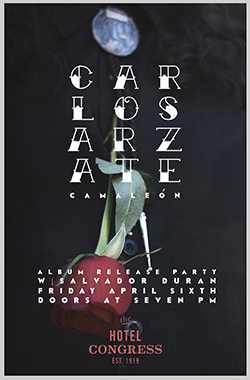
CD Release poster
The idea behind naming the record Camaleón (Español for chameleon) is a nod to the special lizard species that have the impressive ability to change their skin coloration. “There are so many colors that are tattooed into me right now,” Carlos explains. “I feel confident to be able to produce an album where the songs come from all kinds of different styles.
“I’ve been exposed to so much different music and then spent large amounts of time with said different types of music – if it were the hard gangsta rap of the ’90s or the neo-soul of the ’90s or the grunge rock of the ’90s; the progressive rock of Tool, the soul of Marvin Gaye and Sam Cooke and Otis Redding. Growing up listening to Motown with my mom. Loving Prince. The Latin music we listened to as a kid – we grew up with a lot of norteño music,” he details.
Throughout the album, Arzate culls from many of those genres – incorporating soul, Latin rhythms, pop, rock, and the vibe of our Sonoran Desert. The styles may seem disparate, but the tracks flow seamlessly and transition masterfully from one cut to the next.
A few nights after interviewing Arzate, I set up on my back porch, put on the album and settle in for a deep listen. As I hit play, the wind is kicking up and the trees are dancing. The atmosphere – both meteorological and societal – is thick with anticipation. We’re in this early 21st century Zeitgeist, in an intense (snapping point? holding pattern?) at the precipice of – what all? Cultural, racial, environmental, humanistic, religious, evolution/revolution? Entropy in action? Will we stand together or fall apart? Maybe, or not. Both? Nothing? Fragments? Todo? Are we, as Homo sapiens, even that special? These are my thoughts as I reflect on the lyrics. Words that capture a state of humanistic affairs that are both contemporary and timeless.
The album’s first track is “False Alarm,” which seemingly inspires a cricket in my backyard to chime in with song’s opening shimmer. A shimmer that resonates like the fluid movements of a rain stick, or the tinkling of a wind chime. I stop the track. The cricket chirps for another few seconds. Then stops. I start the song again, the cricket chimes in again. Stop. Start. Stop and start. The cricket plays along, then quiets. The rain drops begin to fall.
I start the first cut once again, and the rain comes down steadily now. I am immersed in percussive rhythm that breaks out into a sonically Sonoran-nuanced rock song that speaks to our insecurities of not working hard enough, not being good enough, rich enough, accomplished enough.
It’s an ancient struggle, as Arzate elucidates in our interview. But in these times, we have the added entangled litany of numerous false narratives pushed upon us from myriad media outlets: Choices from the voices/Screaming at your head/They only mean you harm/It’s a false alarm/Screaming at your head. The mix is perfectly balanced with the vox, electric guitar (Conner Gallaher), drums (Winston Watson), bass (Thøger Lund), and Gabriel Sullivan’s percussion and synths.
The song is about the falsehoods of capitalism as culture and economy. We’re pushed to keep climbing this ladder to…where? For what, and to what end? And as intensely as the song builds, plateaus, and crescendos forcefully, it seamlessly transitions into the lulling, gorgeously melodic “Aye Princesa.”
This track is absolutely resplendent with Arzate’s impassioned vox, strings arranged by Ben Nesbit, Efrén Cruz Chávez’s congas, Gabriel Sullivan on guitar, and Ryan Alfred on bass. “It’s probably the most complete story-song I’ve written, it’s like a folk tale,” Carlos imparts. “I wanted it sound like it came out of the ’40s, like my Nana would have listened to as a teenager.”
The chorus, in Español, conveys both the romanticism and tension of the protagonist’s relationship with her padre: Aye Princesa/Con ojos de pearla/Aye Princesa/La hija prodiga.
The delicate ending of “Aye Princesa” melds into the super-chill soul track, “Closer to You,” with drummer Aaron Emery’s tight tapping opening. It spreads out gently with congas (Efrén Cruz Chávez), bass and electric guitar (Ryan Alfred), and Rich Katz on organ – all adeptly moving just under Arzate’s voice. Carlos sings with a genuine sweetness that is imbued with deep love. Horns, by Gary Love and Rick Perino, punctuate the song’s sultry lyrics.
“It’s a little inappropriate,” Arzate says, smiling, acknowledging that his beloved wife Beth inspired the words and sentiment. If you want to melt your lover, play this for them.
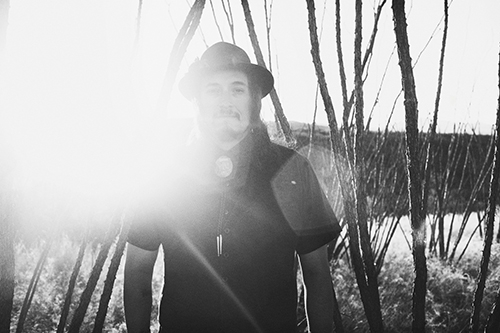
Photo: Puspa Lohmeyer
While the auditory transition to “Broken Glass” – the album’s next affecting soul song – is masterful, it carries an important, yet heavy and emotionally-jarring experience. It forces us to face this country’s embarrassing hypocrisy and deep social inequalities.
But something feels wrong/There’s a lot going on/In the name of progress/In the name of those of us/Living on the outside looking in.
“This speaks to today’s activists, as we transitioned to online activism versus physical activism – where the ‘active’ part of ‘activism’ requires you to go to a rally or go to a march or go clean somebody’s yard,” Carlos shares about the track’s lyrics. “I identified that in myself; it was a bad time for me, I was tired, I was working really hard and I was trying provide for my family,” he explains, specifically about his opening lyrics: None of this is convenient/It’s unfortunately a bad time for me/When you’re miles away from the incident/And uninterested in getting involved.
The tune incorporates a spoken word piece by two lauded local poets, Teré Fowler Chapman and Logan Phillips, who collaborated to bring poignant poetry that punctuate the social injustices thematically covered in “Broken Glass.”
Following is the 40-second instrumental breather, “Redemption,” which slides right into what ought to become an Old Pueblo hymn – “Canopy of Clouds.”
For many Sonoran Desert dwellers, the rain is a rapturous experience; from the sweet, tender caress of the gentle late-winter drizzles to the life-giving (ecological) orgasms released by the driving thrust of summer monsoons. Precluding that dizzying deluge is the tension of inhospitable temperatures, rising moisture and stacking clouds that tease and elude our passionate pleas during the height of summer’s baking drought and inhumane humidity.
To that, Carlos and company created an orchestral ballad with soaring strings, vocals and notes that pay respectful love and attention to the ecstatic marriage of water and earth.
Next is “No Other Place,” an uplifting pop song that is lovable and sweet. It’ll be a fun song to dance to live, and is a bright musical and lyrical respite mixed into the tracks. On “Hold Me Down,” Carlos gets autobiographical with this apologetic love song to his wife. If Carlos is one thing, he is authentic and open. He explains – “I screwed up, I hurt her feelings, and I didn’t realize it.” This tune includes gorgeous backing vox by Steph Koeppen, along with Randy Lopez on organ, Aaron Emery on drums, Gabriel Sullivan on synths, Ryan Green on acoustic guitar and Ryan Alfred on bass.
The next cut, “Try,” opens with beautiful haunting pedal steel played by Conner Gallaher, setting the vibe for this soulful country song – which was inspired by an experience Carlos had at a bar on Tucson’s east side. He observed a lesbian couple at the lively establishment, and no one was talking to the ladies, so he asked if he could sit with them. The three had good conversations, Arzate says.
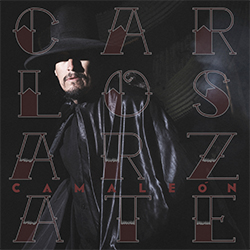
Camaleón album Cover
“They were great, they were recently married, one of the women was from the mid-west, and she was facing a bit of consternation from her family because of her lifestyle. They shared their history, how they met, and I just enjoyed their company. When I was leaving, one of the women looked at me and said, ‘Thanks for leaning in.’ And I said, ‘Anytime.’ And that stuck me so hard. Back to that ‘active’ in ‘activism.’ Social media has marginalized true activism. But that episode – when she said ‘lean in,’ – I thought, ‘that’s exactly right.’”
Following is “Pure,” an exploration of hypocrisy and narratives that dictate absolute ideas of the pursuit of happiness – which features Brian Lopez on guitar. “There’s nuance in the world,” Arzate reflects in our interview. “The idea of purity doesn’t exist, there’s no religious or racial purity.” He sings: How does anybody know what is real and what is pure/I know we are pure together/And the world is bigger than you think.
Wrapping up Camaleón is a loving ode to his three children in “Ramble On,” sharing his adoration and blessings to the kiddos to go out and take on the world. Ramble on, ramble on/Go out and be brave go out and be strong.
We can all take on the world, in its complex nuances, and add our truth and efforts to lean in, resist hypocrisy, embrace love and engage in an authentic life by being brave and strong.
Camaleón was recorded at St Cecilia Studios, Landmark Studios, Dust & Stone Studios between 2016 and 2017. The efforts culminate into the CD release party at Hotel Congress, 311 E. Congress St., on Friday, April 6. The show starts at 7 p.m. and includes performances by Buyepongo and Salvador Duran. Tickets ($8-$10) are available at HotelCongres.com. More information is at CarlosArzate.com or at Facebook.com.
Gabriel Naïm Amor’s “Moments Before”
This nine-track album of instrumentals is gorgeous, sparse, reflective, quiet, understated, and deftly executed – with jazz, orchestral/classical, blues, and cinematic vibes. It gives room for the listener to fill in the stories from one’s own imaginative perspective, or simply the chance to just zone out and let the notes wash over you.
It’s easy to understand the fascinating mix of styles – which is sonically, uniquely Amor – on Moments Before when knowing about Amor’s musical background. He studied classical violin at a Paris conservatory for eight years, and as a teenager, he picked up guitar and played in rock and punk bands. Later, he went to a music school in Paris “run by the great American jazz musician Alan Silva,” the musician writes via email.
 “That school was primarily focused on jazz, but it was really edgy, no purists there; that definitely had a strong influence on me. Then I worked with theater director and author Marc’O with the ensemble Generation Chaos where I developed extensive work on music improvisation and stage acting.”
“That school was primarily focused on jazz, but it was really edgy, no purists there; that definitely had a strong influence on me. Then I worked with theater director and author Marc’O with the ensemble Generation Chaos where I developed extensive work on music improvisation and stage acting.”
Gabriel Naïm Amor says this album has its roots in a project he did with French avant-garde jazz guitarist Nöel Akchoté a few years ago. “He asked me to record guitar pieces very quickly and spontaneously. He completely covered them with noise, some kind of concept. I realized that I really liked these guitar tunes and they deserved an album. So, came the idea of making a guitar album and use all the beautiful instruments I own. I would have all the guitars in the studio and try them on different tunes and say, ‘Yes! This is the one for that song.’”
Amor – originally from Paris, France and a Tucsonan since 1997 – also explains that several of the compositions were written around the same time as the tunes on his 2016 album Western Suite and Siesta Songs. “I was working with (Calexico drummer) John Convertino, and some of the tracks just didn’t make sense on Western Suite, however John really liked them and wanted to drum on them. I realized that I needed more material and I had the direction laying in front of me, just needed to create the missing part, just like a puzzle. It is like curating a mess and finding out what was hiding through it.”
He shares collaboration credit with Thøger Lund, who played on all of tracks, “mostly on electric bass. He also helped a lot with ideas, suggestions with arrangements. John Convertino played the drums, it is so easy to record with him and he brings a lot, he totally felt and understood the breathing and space of that album. Tommy Larkins played on one track one day he was at the studio we shared for a while. Nick Coventry played a violin part on one track, I did all of the strings on the album and of course all the guitars. Jim Waters mixed the album to tape.”
Additionally, Amor offers text he wrote about the album:
“Moments Before, as it indicates, suggests the occurrence of an imminent change or event…small or big, dramatic or light, welcome or disorienting. In opposition to the flat line of death, the pulse of life is celebrated here by the dynamics, contrasts, accidents inherent to any living environment. Unlike a saturation of information often resulting in that monotonous ‘flat line,’ the use of silence and space is attempting to reveal and emphasize each event which hopefully will keep us engaged and interested as a listener.”
Gabriel Naïm Amor performs “Moments Before” at Exo Roast Co., 403 N. 6th Ave., on Saturday, Dec. 16 at 8 p.m. Amy Rude and Heartbeast is also on the bill. See Facebook.com/ExoCoffee for show details or call (520) 777-4709. Visit NaimAmor.bandcamp.com to check out his discography.
Over email, he and I reflect on each of the album’s nine tracks.
Study for ES 125
ZM: It’s a brief, contemplative piece. What was your mind-space when composing this song and what kind of guitar are you playing?
GNA: The guitar is precisely an ES 125, which was made by Gibson, this one is from 1959. That tune was first an improvisation that replicated, rationalized, learned into a written form. I wanted to open the album with a solo guitar, give it the whole space because that’s what the album is about.
She Danced then She Flew Away
ZM: Feels reflective, and understated – especially with the interplay between the guitar and drums. The intersections of the instruments are deftly balanced.
GNA: I wanted to have a beautiful punctuated by a very strong sonic, dissonant part.
Waltz Escape
ZM: I love the pacing of the notes. Sparse, open, yet expressive – beautifully balanced. Interesting change/bridge around the two-minute mark. Tell me about that transition.
GNA: Here it’s the idea of have a two-songs-in-one type of composition, it’s kind of a classical approach yet not classical at all.
Somewhere Else
ZM: Darker, feels trepidatious at the beginning, definite tension – which mellows out around 1:50 mark. There’s a lighter touch, quieter, more like a lullaby. Ends sweetly.
GNA: Here I wanted to enjoy that contact of tension and release, I like laying down closing my eyes and listen to that track, kind of meditative.
Reverse Dawn Back Into The Night
ZM: I love the sense it gives of going backward. It’s like a reflection of life, looking back/traveling back. It conveys a wonderment of the natural world with shimmering sounds – dreamy and reflective. I love the interplay/call and response between the strings. The time from 3:06 to end feels like a culmination of experiences.
GNA: You are exactly right; this piece is kind of surreal to me. I originally composed it for a film by Ira Chute about some guys cutting trees in the woods. I re-worked it for the album and I was initially inspired by the score and the scene of the two little children in a boat on a river in the middle of the night from the great movie “The Night of The Hunter” with Robert Mitchum.
Back Porch Moment
ZM: I dig that you have a song with this title. I feel like Tucson is almost defined by its locals as a town that celebrates its back porches/outdoor chill spaces. Kicking back, and enjoying a libation with friends and talking about life, the world, being backyard philosophers. This song seems to encapsulate that sentiment.
GNA: That’s a perfect example of curation, the song handed me the title afterwards…that’s what is great with instrumentals!!
Just Before Revelation
ZM: Conveys feelings that vacillate between certainty and confusion.
GNA: Here again, the dynamic is emphasized by having two songs in one, like movements in classical music. It also has a strong reference to the blues but it’s not Blues, a bit like Gershwin used some blues and jazz harmonies in his Rhapsody maybe.
Ouled Kacem To Paris
ZM: Did you travel between Tunisia and Paris at one point? Opens with measured, dark, quiet. Please tell me about the background of this song and its title. It feels very cinematic. Is there a story behind it?
GNA: My father is from Tunisia, he moved to Paris alone in 1954, he was seventeen and wanted to be an artist. Ouled Kacem is the tiny village where he was born and that he left. That song has a slight Arabic feel but it also has a rockabilly electric guitar tone, that what I like the most about it, that collusion. Like my father I left my country, I thought there was an emotional feel to drive that tune.
Study for Telecaster
ZM: An ode to a guitar?
GNA: It’s the closing track and mirrors the opening one, the titles are similar, I used my beautiful 1954 Fender Telecaster.
Mindful in a World of Distractions: Leila Lopez’s “Our Animal Skin”
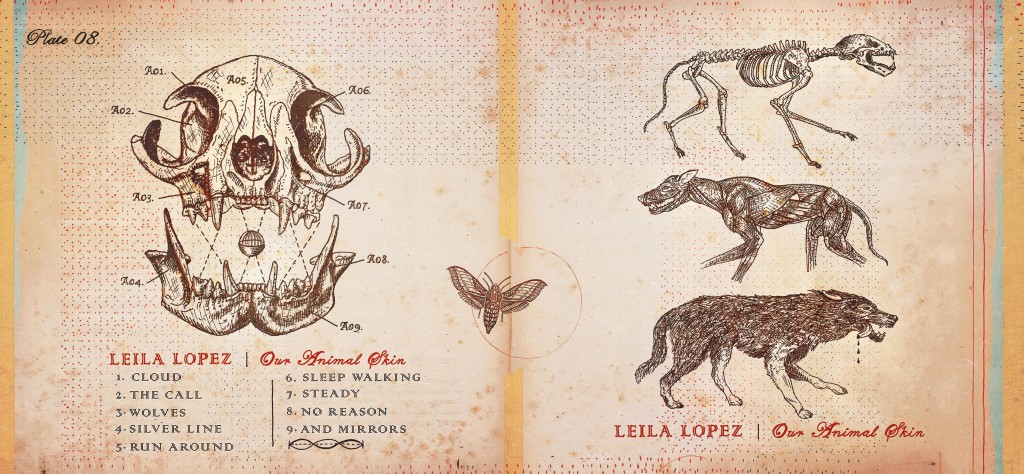
Artwork by Daniel Martin Diaz
Leila Lopez writes songs that explore the depths of human relationships, with ourselves and others, and our emotional struggles as we move through this thing called life. She is vulnerable, resilient and authentic, sapient, contemplative, kind and loving, and her richly layered folk songs are imbued with those attributes.
The album is also imbued with a gentle acceptance of life’s pain, joy, challenges, and ephemeral nature. It conjures the Japanese concept “mono no aware,” the poignant, wistful reflection on the transience of existence; calling on us to be mindful and have faith that we’ll receive what we need, as being distinct from what we want.
Over email, Leila shares the dichotomies she writes about: struggling with depression while pretending like everything is okay, “the climb and fall, shadow and light, the high and low.
“My grandmother passed a couple years ago, and she was always the voice of reason for me. Light needs the dark, sorrow paves the path for joy.”
Through discussing the songs, it’s clear this is a deeply personal project that took some time. “The album was written over a period on and off of about three years, starting around spring of 2013,” Lopez explains. “The songs ended up coming together organically, but as somewhat of a timeline, or chain of events that felt cohesive to one another. They came slowly and I let them, not wanting to put pressure on the process, and to genuinely respect the space in between so I could keep it fun and natural.”
Her intuition was spot-on; the flow of the songs is seamless. And pretty much by herself in her home studio, Lopez created a gorgeous, heart-rendering album that features her playing almost every instrument: vocals, backup harmonies, guitar, bass, drums, keyboard, mandolin, and cello. The sole exception is Christabelle Merrill’s violin on one track.
The songs on the album are beautiful, poignant, interesting, and they collectively provide an examination on how life moves and morphs us. So, what is “our animal skin” and why is it important to shed it?
“The album name came from (aside from the actual lyric) the feeling that I keep having about time, and where we have been, and who we become along the way. The layers we shed both internally and externally change us whether we want them to or not. We go through this process on our own, or maybe in different relationships throughout our lives. Can we adapt to our new layers? Can we fully support the ones we love through the tides even though they may be uncertain? Sometimes we don’t even know why it’s important to shed some of our layers, or for others to do the same, and we just have to trust the process and know that whatever comes is an opportunity for so many things. We are leading ourselves along, but in so many ways, we are also just tiny particles in a really big current.”
Enjoy Leila’s songs – with bandmates Brian Green (bass), Christabelle Merrill (violin) and Julius Schlosburg (drums) – live on Friday, Sept. 22 at Flycatcher, 340 E. 6th St., starting at 8 p.m. Dutch Holly opens. Free! Details at Facebook.com/leilalopezsongs.

Leila Lopez

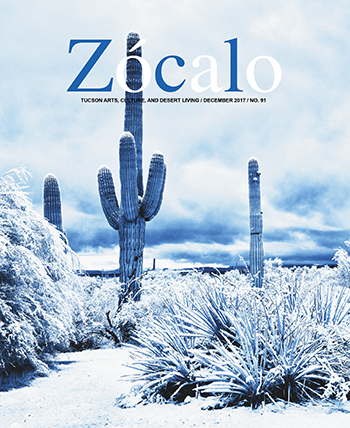
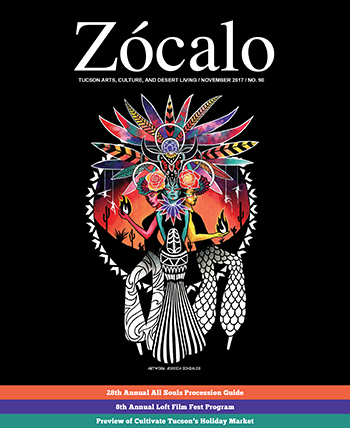
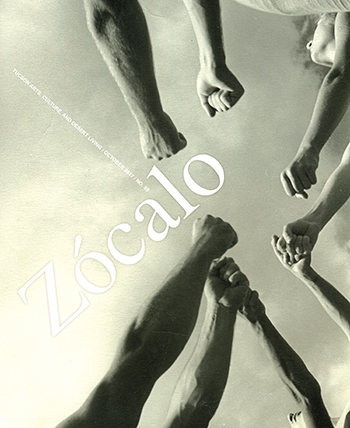
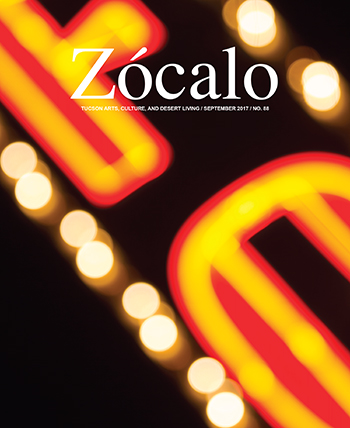




Also find us on...